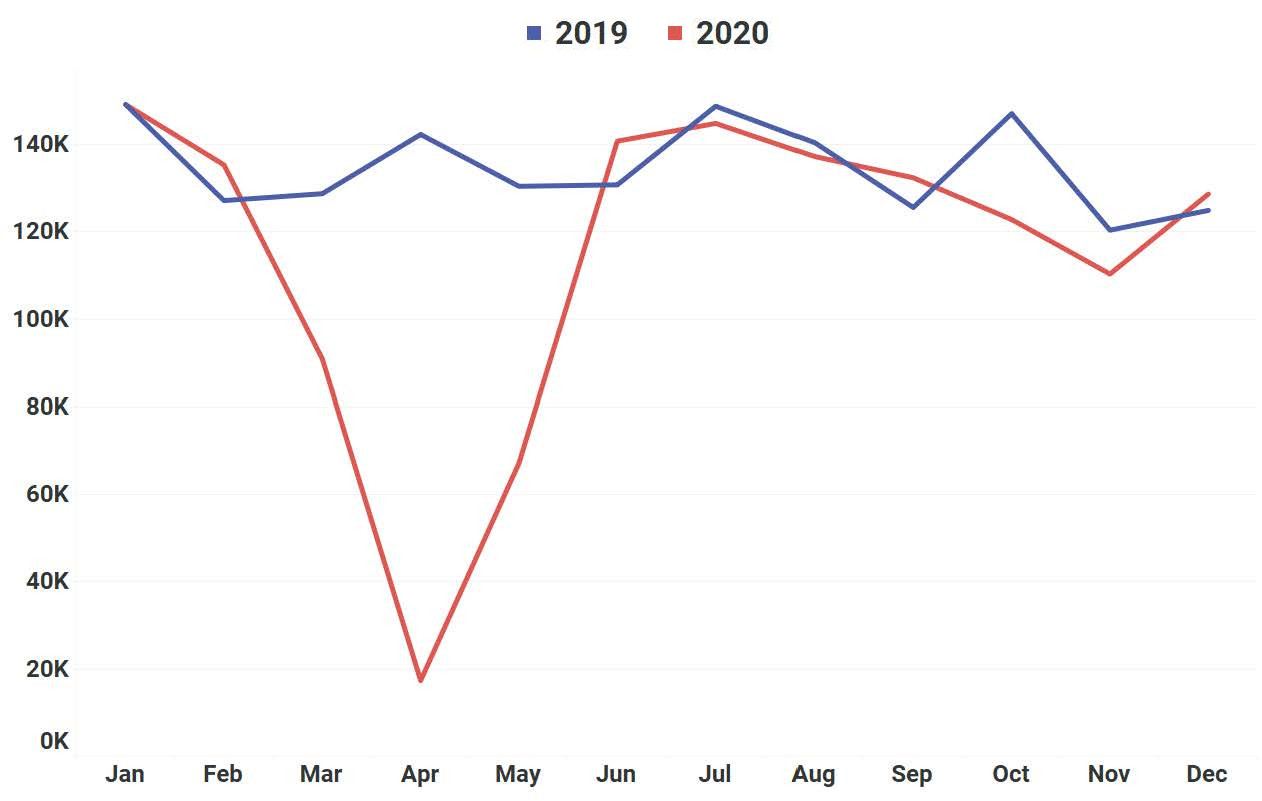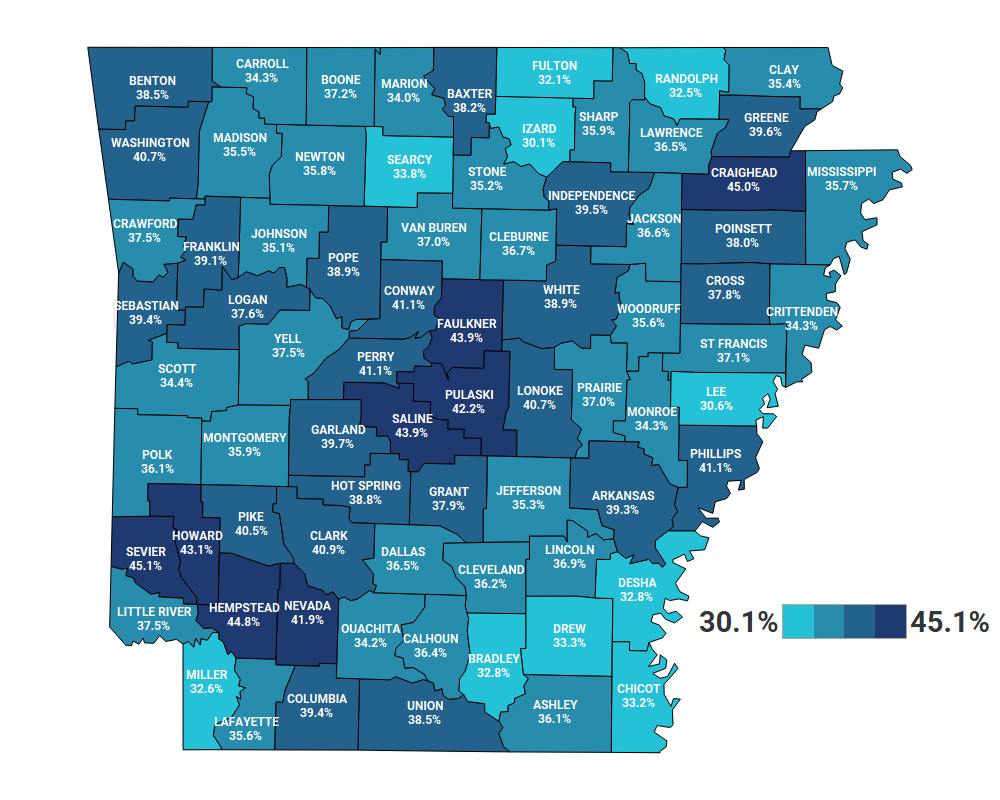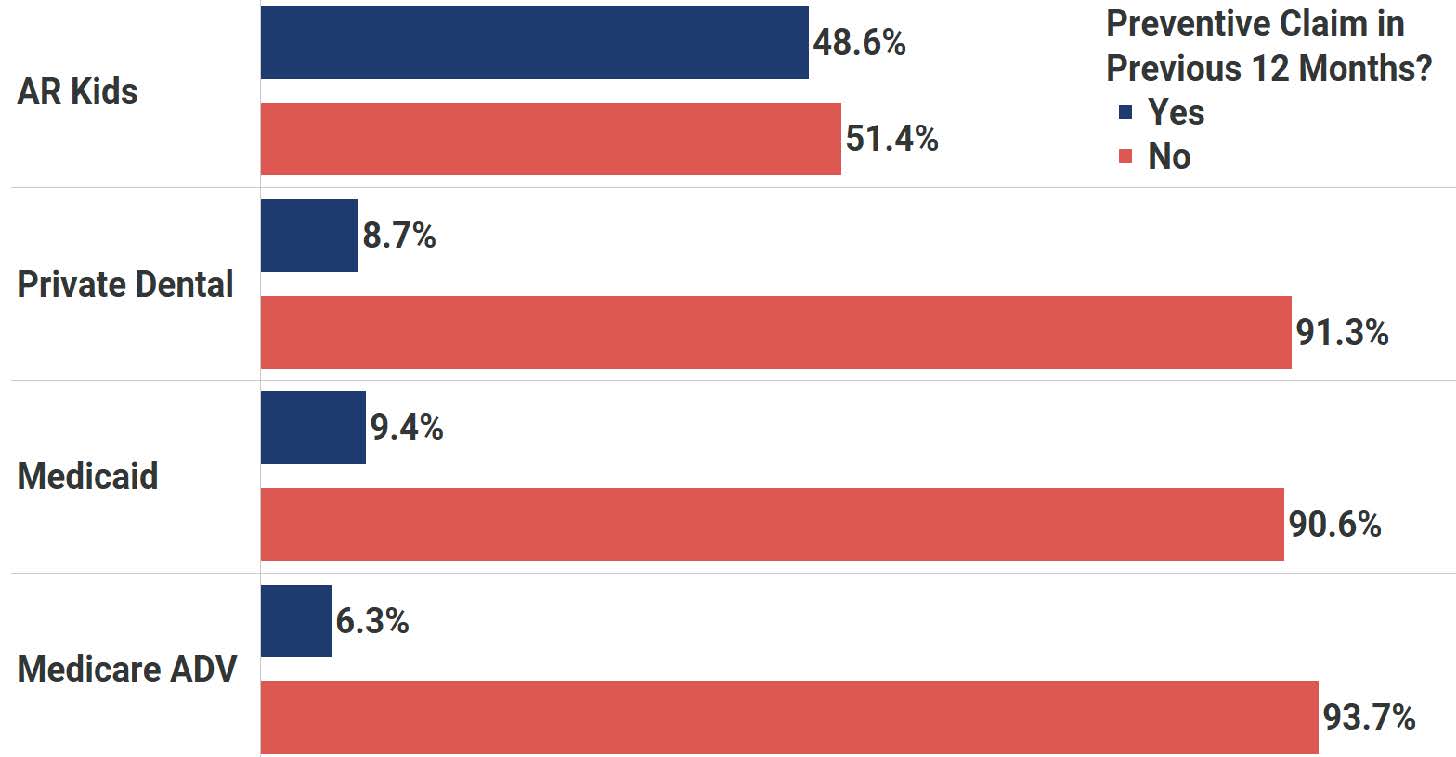Oral Health in Arkansas
Oral health is a key indicator of overall health. It refers to the health of teeth, gums and the entire oral-facial system that allows us to smile, speak, and chew.
The Arkansas Center for Health Improvement (ACHI) and the Delta Dental of Arkansas Foundation partnered to undertake a study to further inform policy decisions supporting improved access and utilization of dental care, and to establish baseline measures for dental coverage, dental service utilization, dentist-to-population ratios, COVID-19 impacts, and other key measures.
Tooth decay remains one of the most prevalent chronic childhood illnesses in the United States, with about one out of every five children aged 5 to 11 years and one out of seven children aged 12 to 19 years having at least one untreated decayed tooth. While the American Academy of Pediatric Dentistry (AAPD) recommends that all children have biannual dental examinations, many children in Arkansas do not receive adequate dental care, even with dental insurance coverage. Among adults in the state, 38% reported the condition of their mouth and teeth as fair or poor, and only 57% reported having a dental visit in 2020. Oral disease can cause significant problems such as loss of tooth structure and function, pain, anxiety, and embarrassment, all of which can greatly affect an individual’s quality of life and overall health.
As Arkansas’s healthcare delivery system faces the continued effects of the COVID-19 pandemic, the downstream impacts to oral health can be better understood through analyses of COVID-19-era dental care utilization rates. This report includes trend information throughout 2019 and 2020 by type of dental treatments, age, and payer type, and displays utilization impacts as a result of the unprecedented near-total pause in dental care provision during the onset of the pandemic in Arkansas.
This report includes analytic outcomes meant to support the increase of Arkansans who receive any preventive dental services, and to decrease the proportion of individuals with untreated dental decay.
Key Measures in This Report
- Dental insurance coverage and demographic profiles by county
- Analyses of proportion of individuals receiving any dental services within a year, by service type
- COVID-19 impacts on utilization trends and downstream service utilization
- Utilization of dental care in medical settings, including hospitals and emergency departments
- Profile of uninsured utilization and related charges for dental care in emergency departments
- Fluoride varnish application trends in dental and medical settings, and sealant applications profile
- Dental extraction-related opioid prescribing profile
Key Findings
- 54% of Arkansans had some evidence of dental coverage in the Arkansas All-Payer Claims Database (APCD) for 2019 (1.6 million individuals).
- In 2019, only 30.4% of adults with dental coverage used any services, and 50.5% of children with dental coverage used any services.
- Individuals with private dental coverage utilized preventive services at a higher rate than adults on traditional Medicaid, with variation across counties.
- COVID-19 dramatically affected dental care utilization in the state, with overall utilization decreased by 56% in March through May of 2020 compared to the same period in 2019; monthly utilization mostly returned to pre-COVID levels by the end of 2020.
- Many counties, particularly rural ones, appear to have too few active dentists providing services.
- Fluoride varnish application by dental and medical providers has steadily increased since 2013, with the exception of 2020.
STATEWIDE UTILIZATION TRENDS: OVERALL SERVICES IN DENTAL SETTING, PER MONTH, 2019–2020
COVID-19 dramatically affected dental care utilization in the state, with overall utilization decreased by 56% in March through May of 2020 compared to the same period in 2019; monthly utilization mostly returned to pre-COVID levels by the end of 2020.

PERCENTAGE OF INDIVIDUALS WITH DENTAL COVERAGE WHO USED ANY DENTAL SERVICE, BY COUNTY, 2019
In many areas of the state, too few individuals utilize dental care. The counties with higher percentages of utilization are generally located in the Central and Southwest regions of the state. At 45.1%, Sevier County residents had the highest percentage of utilization of any service, followed by Craighead County (45.0%), and Hempstead County at (44.8%). The county with the lowest percentage of utilization of any service was Izard County at 30.1%, followed by Lee County (30.6%) and Fulton County (32.1%).

HISTORY OF PREVENTIVE VISITS AMONG INDIVIDUALS WITH DENTAL SERVICE-RELATED CLAIMS IN EMERGENCY DEPARTMENT SETTINGS, BY DENTAL COVERAGE TYPE, 2019
Regular dental visits can help patients avoid dental problems that require emergency treatment. Still, too many Arkansans seek dental care in medical settings including emergency departments (ED). ED utilization for dental care was substantially lower among individuals who had any preventive dental care in the previous 12 months. Among patients with private dental coverage, Medicaid, or Medicare Advantage that sought dental care in an ED, over 90% had not received any preventive dental care in the previous 12 months.

Utilization of Dental Care Among Arkansas Children and Adults
Due to the Arkansas Transparency Initiative which includes the APCD, authorized in April 2015 through Act 1233, we now have access to dental claims data for patients covered by private dental insurance to assess both supply of, and demand for, dental services. As more recent dental and medical claims data become available, further analyses of COVID-19 impacts will help policy leaders better understand challenges and needs associated with oral health and dental care utilization in Arkansas. Future studies may support further study of the impacts of dental care (or lack thereof) on specific medical conditions and overall health outcomes.
EVEN BEFORE PANDEMIC, MOST ARKANSANS WERE NOT MAKING REGULAR DENTIST VISITS, ACHI REPORT FINDS
Report Also Suggests Link Between Lack of Regular Dentist Visits and Dental Emergencies
LITTLE ROCK ― (June 2, 2022) A report on oral health in Arkansas released Thursday by the Arkansas Center for Health Improvement finds that even before the COVID-19 pandemic, most Arkansans were not making regular visits to the dentist, even if they had dental insurance ― and use of dental services dropped even more during the first year of the pandemic.
The report, released during Oral Health Month, also suggests a link between lack of preventive dental care and dental emergencies: Among Arkansans with dental insurance who sought treatment in emergency departments for dental problems in 2019, over 90% had not been to a dentist in the previous 12 months.
ACHI reviewed insurance claims data from the Arkansas All-Payer Claims Database, as well as hospital and emergency department discharge data from the Arkansas Healthcare Transparency Initiative, to study usage of dental services by Arkansans between January 2019 and December 2020. The report, funded by and developed in partnership with the Delta Dental of Arkansas Foundation, is available at achi.net/oralhealth.
Findings in the report include:
- Fifty-four percent of Arkansans, or 1.6 million individuals, had evidence of dental insurance in 2019.
- Only 30%, or about one in three, of Arkansas adults age 19 or older with dental insurance used any dental services in 2019. About 51% of Arkansas children age 18 or younger with dental insurance used any dental services in that year.
- Among Arkansans with private, Medicaid or Medicare Advantage dental insurance who sought dental care in an emergency department in 2019, over 90% had not received any preventive dental care in the previous 12 months.
- Use of dental services was lowest in rural parts of the state in 2019, with 37% of rural county residents visiting a dentist compared to 40% of urban county residents.
- The pandemic had a major impact on use of dental services. Between March 2020 and May 2020, during which period the state Department of Health called on dentists to suspend non-urgent services to slow the spread of COVID-19, use of dental services by Arkansans with dental insurance decreased by 56% compared to the same period in 2019. Monthly utilization generally returned to pre-pandemic levels by the end of 2020.
- The percentage of Arkansas adults with dental insurance who visited a dentist at any point in 2019 was 30%; in 2020, only 25% visited a dentist. Among children with dental insurance, 51% visited a dentist in 2019 and 44% visited a dentist in 2020.
- Access to dentists is limited in some parts of the state. In 2019, 11 Arkansas counties had dental provider shortages, defined by the Health Resources and Services Administration as a ratio of 5,000 or more residents per dentist. Those counties were Chicot, Cleveland, Lafayette, Lawrence, Lee, Little River, Newton, Pike, Prairie, Scott and Woodruff. Two of those counties, Cleveland and Lafayette, had no active dentist in 2019.
- The percentage of dentists serving children enrolled in the ARKids First children’s insurance program varied greatly from county to county in 2019, ranging from 100% in some counties to zero in others. Statewide, 61% of dentists served ARKids enrollees in 2019.
- Fluoride varnish application by dental and medical providers has trended upward and steadily increased since 2013, with the exception of 2020, during which overall levels of dental care utilization were lower than in previous years
“A visit to a dentist for preventive care one or twice a year is commonly recommended by dental care providers, but our report shows that even most Arkansans are not heeding that advice, even if they have dental insurance,” said ACHI Director of Analytics Mike Motley. “The report is intended to inform policy decisions that will promote better oral health in the state.”
“This report shows why preventive care is important,” said Dr. Susan Ward-Jones, CEO of East Arkansas Family Health Care Inc. “When Arkansans seek emergency dental care, an overwhelming percentage of them have not been to a dentist in over a year.”
ACHI is a nonpartisan, independent health policy center that serves as a catalyst for improving the health of all Arkansans through evidence-based research, public issue advocacy, and collaborative program development. With oversight from the Arkansas Insurance Department, ACHI maintains the Arkansas All-Payer Claims Database, a repository of insurance claims data that is part of the Arkansas Healthcare Transparency initiative. The initiative was authorized under Arkansas Act 1233 of 2015 to promote transparency in the state’s health care system. More information is available at achi.net.
The Delta Dental of Arkansas Foundation is committed to fulfilling Delta Dental of Arkansas’s mission to improve the oral health of all Arkansans. Since 2015, the foundation has contributed an average of $1 million per year to local communities to support oral health education, prevention and treatment programs. More information is available at deltadentalar.com/giving-back/delta-dental-of-arkansas-foundation/about.
###
About Delta Dental of Arkansas Foundation: The Delta Dental of Arkansas Foundation is committed to fulfilling Delta Dental of Arkansas’s mission to improve the oral health of all Arkansans. Since 2015, the Foundation has contributed an average of $1 million per year to local communities to support oral health education, prevention and treatment programs. More information is available at https://www.deltadentalar.com/giving-back/delta-dental-of-arkansas-foundation/about.
About ACHI: ACHI is a nonpartisan, independent health policy center that serves as a catalyst for improving the health of all Arkansans through evidence-based research, public issue advocacy, and collaborative program development.


